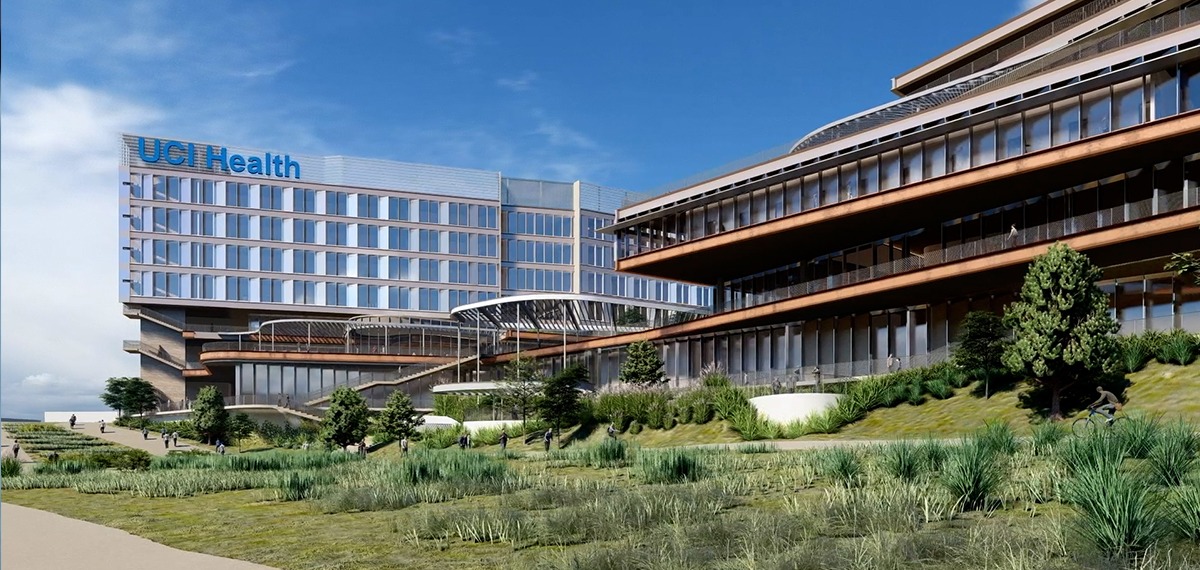UCI is making medical and environmental history with the opening of America’s first all-electric acute care hospital set for Dec. 10. The $1.2 billion facility is designed to provide state-of-the-art patient care while working towards the University of California (UC) system’s goal to reduce 90% of its total carbon emissions by 2045.
Located at the corner of Jamboree Road and Birch Street, the new Irvine Campus Medical Complex (ICMC) will serve as a center for acute and ambulatory care, advanced cancer treatment and research with 144-beds, seven stories and nearly 1,000 staff. The ICMC will include 24-hour emergency care and specialties in cardiology, neurology, orthopedics, spinal care, digestive health and oncology — all powered by clean electricity.
The healthcare industry contributes to 8.5% of all carbon emissions, according to UCI Health. UCI Health’s existing medical center in Orange, Calif., relies on natural gas for about 25% of its power. Natural gas emits methane, a greenhouse gas much more potent than carbon dioxide.
Hoping to reduce greenhouse gas emissions, UCI considered early in the planning process simply cutting back on fossil fuels. However, after consulting with engineers, the university decided to go the extra mile and eliminate natural gas use entirely.
“The operation of this campus will have no emissions,” Joe Brothman, director of UCI Health general services, said in an interview with the LAist. “The energy that we’re utilizing is all green electricity that we’re importing.”
All of the facility’s power will come from renewable sources, including solar and wind. Solar panels installed on top of parking structures will help generate electricity on-site, while the remaining power will be sourced from Southern California Edison’s renewable energy program that allows customers to choose how their electricity is generated.
Since no all-electric hospital of this scale has been constructed until now, the engineers had to be creative and start from scratch. The project’s engineering team, led by the WSP company tk1sc, used extensive computer modeling to design a system that could recover and reuse energy within the ICMC itself.
The hospital’s central utility plant (CUP) is the first in the UC system to operate solely on electricity. The plant’s systems were designed to recycle energy wherever possible instead of releasing it outdoors. In the process, systems recover heat from hospital operations to warm the building and its water. This plan required intricate planning of heating and cooling loads, air flow and energy balance to ensure maximum efficiency across every department.
“We spent many full day workshops educating the contractors, commissioning agents and owners team on how to implement and operate these new sequences which not even the engineers at the OEM [Original Equipment Manufacturer] fully understood or imagined possible,” Mitchell Fisher, design engineer, said in the UCI ICMC All-Electric CUP Controls Design.
Beyond the innovative engineering behind the scenes, patients and visitors will be greeted with earth tones, eye-catching nature motifs and the beauty of the adjacent San Joaquin Marsh Reserve, creating a tranquil environment. Project designers were keen on incorporating an environmentally friendly theme, particularly noting the biodegradable and recyclable materials in the furnishings and flooring.
Additionally, each room includes a 75-inch smart TV for easy care coordination, entertainment and food ordering for patients. Sound alerts are routed directly to staff devices instead of echoing through hallways, greatly reducing noise and stress.
“It creates a cleaner, quieter space that helps patients heal and makes our work as nurses more efficient and connected,” a nurse at the Perioperative Unit of the UCI Health Chao Family Comprehensive Cancer Center told New University.
UCI is also preparing for its next endeavor in clean energy. Engineers designed it to use direct current (DC) power from renewable sources, which would eliminate the energy loss that occurs when converting electricity between DC and alternating current.
“We’re really being intentional about our impact to this area being as little as possible so we can deliver the highest level of healthcare with minimal impact to the place aroun us,” UCI Health emergency medicine physician Dr. Ryan Gibney told CBS News.
Anika Denny is a News Staff Writer. She can be reached at adenny1@uci.edu.
Editor’s Note: This article was corrected on November 19, 2025 towards the University of California system’s policy and goal to reduce carbon emissions.

